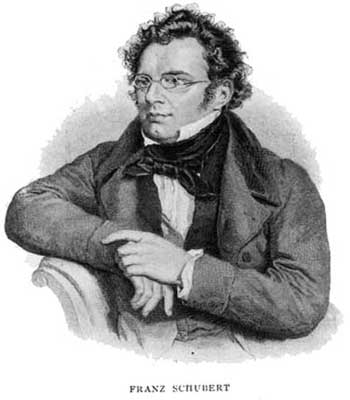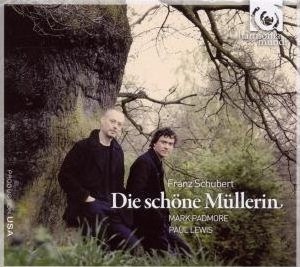Few great works of art are as disarming as Schubert’s Die Schöne Müllerin. With its folksong-like melodies and deceptively simple harmonic palate, it is quite hard to account for the cycle’s profound emotional effect. How is it that over the course of 20 songs we fall under the spell of a naïve and sentimental lover, a slightly effeminate, self-obsessed boy who, no sooner than he sees a rival, despairs and drowns himself?
Part of the answer becomes apparent when we look at the poetic source for the cycle. The poems that Schubert found in Wilhelm Müller’s anthology, The Posthumous Papers of a Travelling Horn-Player, have an ironic and sophisticated tone entirely absent from Schubert’s music. In particular, a Prologue and an Epilogue (not set by the composer) warn the reader not to take things too seriously and serve to undermine the sentimentality of the protagonist. It is no surprise to learn that the master of poetic irony, Heinrich Heine (pictured below: portrait by Moritz Oppenheim), admired Müller’s verse.
 Schubert was, however, in no fit state to appreciate satirical frivolity. In late 1822 or early 1823 the venereal disease that would kill him five years later first became apparent. His health and his prospects were destroyed; an early and painful death was almost certain, quite possibly to be preceded by insanity and destitution. It is little wonder then that Schubert couldn’t bring himself to join in Müller’s gentle mocking of the miller lad. Instead he seems to identify with him in complete and open-hearted sincerity.
Schubert was, however, in no fit state to appreciate satirical frivolity. In late 1822 or early 1823 the venereal disease that would kill him five years later first became apparent. His health and his prospects were destroyed; an early and painful death was almost certain, quite possibly to be preceded by insanity and destitution. It is little wonder then that Schubert couldn’t bring himself to join in Müller’s gentle mocking of the miller lad. Instead he seems to identify with him in complete and open-hearted sincerity.
Die Schöne Müllerin, therefore, contains very little of the dark, strange world that Schubert would explore later in Winterreise or the Heine songs in Schwanengesang. The tonality is predominantly major key – of the first 13 songs only one starts in the minor – and the vocal writing is lyrical and expansive. Much use is made of arpeggios in the voice part, calling to mind alpine yodelling – think of the opening of the first song, Das Wandern, the refrain of Ungeduld or the whole of Mein – and the most hopeful of intervals, the upward major sixth, is used to great effect – for example in Morgengruss, Ungeduld, Pause and towards the end of Des Baches Wiegenlied. Strophic songs also abound, adding to the folksong-like character (and, incidentally, making memorising the cycle somewhat treacherous!) As Dietrich Fischer-Dieskau has said, the songs of Die Schöne Müllerin taken separately are not masterpieces in the way that the songs of Winterreise are, but the overall effect is far greater than the sum of the parts.
Schubert’s genius lies in his alchemical ability to transform apparent simplicity into some of the most touching and deeply moving music ever written. A great example of this genius is the song Nacht und Träume written in 1822, the year before Die Schöne Müllerin. The very slow tempo in 4/4 contains 16 rocking semi-quaver chords per bar. For five magical bars in the middle of the song nothing happens except a C major chord for two bars, followed by a G major chord for two bars, followed by one more bar of C major. The daring to do nothing is breathtaking and again and again in Die Schöne Müllerin we are surprised and delighted by the way that Schubert captures exactly the naivety and candour of his miller lad with the simplest of means.
 Take, for example, the song Der Neugierige with its meditation on the difference between the words “yes” and “no” for a hopeful lover. The opening section is almost monotonous in its repeated modulation to the dominant, the vocal line seems stuck, unable to form a completed musical sentence and ends as if broken off in mid-thought. Then magic happens – silence. Schubert notates with a crochet and quaver rest the entire thought process of the rest of the song. It is an extraordinary act of communication on the composer’s part to any future performer of the song. We must engage with that silence; it signifies an unanswered, perhaps unanswerable question and on it hinges the fate of a young man. “To be or not to be” written with a beat and a half of rests. The wavering between B major and B minor that follows perfectly describes the two possible outcomes and although the song resolves itself, finally, in the major we are left in no doubt of the potential for failure.
Take, for example, the song Der Neugierige with its meditation on the difference between the words “yes” and “no” for a hopeful lover. The opening section is almost monotonous in its repeated modulation to the dominant, the vocal line seems stuck, unable to form a completed musical sentence and ends as if broken off in mid-thought. Then magic happens – silence. Schubert notates with a crochet and quaver rest the entire thought process of the rest of the song. It is an extraordinary act of communication on the composer’s part to any future performer of the song. We must engage with that silence; it signifies an unanswered, perhaps unanswerable question and on it hinges the fate of a young man. “To be or not to be” written with a beat and a half of rests. The wavering between B major and B minor that follows perfectly describes the two possible outcomes and although the song resolves itself, finally, in the major we are left in no doubt of the potential for failure.
This is a small example of the exquisite engagement with the moment that Schubert asks for from performers and audience alike. He paints each step of the young man’s journey with such subtlety and detail that we become, almost unconsciously, his companions. The effect is cumulative, each song gaining power from what has gone before and this accounts for the overwhelming emotional impact of the last three songs.
 I have now performed the cycle many times with many wonderful pianists but I still find it very hard to imagine, as I set off on the journey, the place that we will arrive at an hour or so later. There is something about Schubert’s ability to smile through the tears that is heart-breaking. We can only imagine what this cost a young man of 26 who was facing the terrible prospect of an early death. We can only wonder and be grateful for the gift he gave us.
I have now performed the cycle many times with many wonderful pianists but I still find it very hard to imagine, as I set off on the journey, the place that we will arrive at an hour or so later. There is something about Schubert’s ability to smile through the tears that is heart-breaking. We can only imagine what this cost a young man of 26 who was facing the terrible prospect of an early death. We can only wonder and be grateful for the gift he gave us.
- Mark Padmore's recording of Die Schöne Müllerin with Paul Lewis is on Harmonia Mundi















Add comment